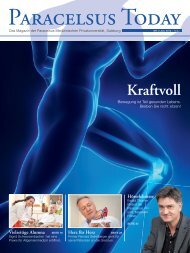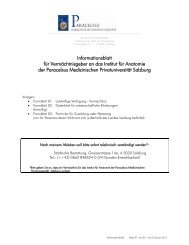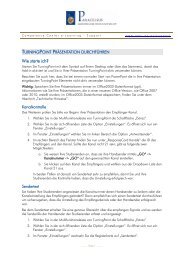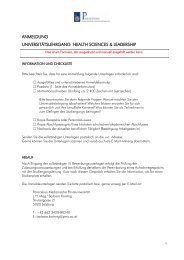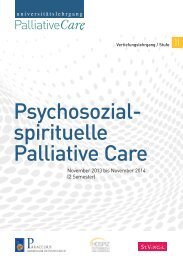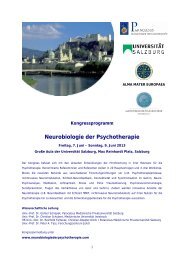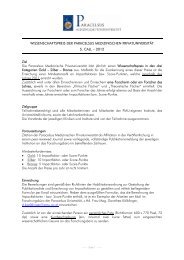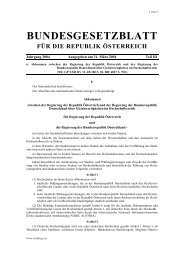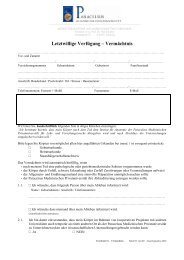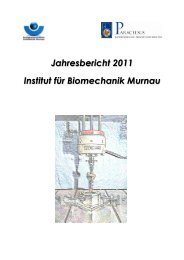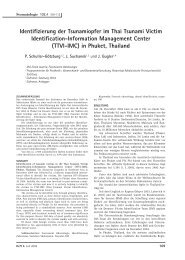Salzburg, am 4 - PMU
Salzburg, am 4 - PMU
Salzburg, am 4 - PMU
You also want an ePaper? Increase the reach of your titles
YUMPU automatically turns print PDFs into web optimized ePapers that Google loves.
“SPINAL CORD INJURY AND TISSUE REGENERATIONCENTER SALZBURG (SCI-TReCS)” AT THEPARACELSUS MEDICAL UNIVERSITYQUERSCHNITT- UNDGEWEBEREGENERATIONSZENTRUM SALZBURGDER PARACELSUS MEDIZINISCHEN PRIVATUNIVERSITÄT2. Half-Year Interim Report<strong>Salzburg</strong>, January 2013
SCI-TReCS 2. Half-Year Interim Report: July 2012 – December 2012:PREAMBLE:As the constructions of the <strong>PMU</strong> building (M2, Strubergasse) fortunately proceed intime we are happy that beside the physical development of this future activity areaalso the intellectual SCI-TReCS substance is prospering. For an efficient setup of thewhole SCI-TReCS community and the realization of the ideas behind SCI-TReCS it isimportant to establish and cultivate the enthusiastic spirit that drives us from the ideasto real life.a) Department of TraumatologyPATIENT CARE:Within the ASCIS study (Austrian Spinal Cord Injury Study; with 23 participatinghospitals), many of these patients were treated at our department. So far we registered35 patients from 8 different hospitals (4 female, 31 male). The patients‘ ageranges from 15-88 years (average: 45 years). Neurophysiolgical investigationswere done in cooperation with the Department of Neurology of the ChristianDoppler Klinik (CDK). At the moment we are reinvestigating the first patients oneyear after trauma.In two patients the bone regeneration process after traumatic injury could beimproved by applying their own bone marrow-derived stem cells in the course ofa surgical intervention. (Cooperation with Stem Cell Research Unit Graz and theDepartment of Transfusion Medicine <strong>Salzburg</strong>)b) Department of NeurologyThe standards of care for nurses treating patients with SCI have been establishedand the project: ―Pflegeprozess für Querschnittspatienten‖ is fully implemented.Patients with spinal cord diseases (traumatic and non traumatic SCI) have beencontinuously treated at the Neurorehabilitation Unit of the Department of NeurologyThe collaboration of physiotherapist and occupational therapists with other centersfor Paraplegiology has been further deepened and a project with the Institutefor ―Nursing Science <strong>PMU</strong>‖ (Prof. Osterbrink) has been outlined.Acute diagnostic for SCI including neurophysiology investigation have been establishedto serve the Departments of Neurology and Traumatology (2 evokedpotential machines and TMS machines).SCI-TReCS CommitteeParacelsus Medical University—— Page 2 ——
Neurourology visits for SCI patients and other spinal cord diseases have been establishedin collaboration with the Department of Urology.c) Department of UrologyStandards for Urodyn<strong>am</strong>ics (UD) in paraplegic patients have been developedregarding patient handling, performing UD, adequate interpretation and nursery.A special dedicated nurse has been identified, promoted and educated for SCIoutpatient treatment and for optimized inpatient care.This is a basis for further evolution of special nursery for SCI patients in terms ofeducation and nursing sciences.A nurse has been specially trained to optimize care for incontinence, bladdereducation and use of utilities/auxiliary devices in particular for SCI patients. This isto support patients in their change of daily life after SCI as the dysfunction of thelower urinary tract is one of the most dr<strong>am</strong>atic social cuts for both patient andrelatives.Incontinence advisory services and utilities support have been set up in our outpatientdepartment to maintain the best possible standard of care for SCI patientliving at home.Neurourological standards regarding bladder dysfunction and handling of utilitiesin different clinics within the SALK are established to define a standard care in thedifferent stages of SCI course. This goal is extended to other neuro-urological diseasesas well (MS).Monthly consultation hours have been established for patients treated by SacralNeuromodulation (SNM) to ensure regular reliable follow up and to guaranteehighest possible standard of SNM supervision and adjustment.INFRASTRUCTURE:a) Institute of Molecular Regenerative MedicineCore facility „Animal Surgery‟ development:For the investigation of tissues from cells and organs in the living animal, a Digital StereotaxSystem, in combination with specific software, was installed. This tool is importantespecially for the pre-clinical research.Digital Stereotax System (Stölting Europe)Date installed: 13/09/2012Noldus Ethno Vision Base Software incl. Encoder, Plus Contract and PCDate installed: 20/08/2012SCI-TReCS CommitteeParacelsus Medical University—— Page 3 ——
Core facility ‗Small Animal Imaging‘ development:The XGI-8 anesthesia system is used to anesthetize mice undergoing bioluminescentor fluorescent whole body imaging.XGI-8 Anesthesia-SystemDate installed: 14/12/2012b) GMP-Unit / Department of Transfusion MedicineCore facility „Microscopy‟ development:The equipment includes two confocal laser scanning microscopes and one uprightfluorescence microscope. High-end 3D and 4D imaging, image reconstruction aswell as live cell imaging technologies will be available for all SCI-TReCS researchers.LSM 700 (ZEISS)Confocal MicroscopeDate ordered: 11/12/2012 – delivery projected 01/2013Nucleofection is an efficient electroporation technology for introducing DNA, RNAspecies, proteins or synthetic compounds into otherwise difficult to manipulate cellsusing a combination ofelectrical par<strong>am</strong>eters and specific buffers.Nucleofector 4D (LONZA)Electric pulse cell transfection deviceDate installed: 08/10/2012„GMP facility‟ development:Offers for the construction of the GMP clean room were received and scored accordingto a defined matrix. Final consultations with potential companies will be heldin January. Similar procedures have been initiated for clean room equipment (incubators,class A sterile cabinets, liquid nitrogen tanks, freezers, etc.) and commissioningis expected in February / March 2013.c) Institute of Tendon and Bone RegenerationCore facility „Histology‟ development:Instruments listed below are basic tools for the investigation of tissues. The ―Kryostat‖ isa highly precise state-of-the-art microtome, that enables to cut very thin slices of tissue(~ 1,0 µm) for microscopic evaluation.Leica Microsystems: Leica CM1950 – KryostatDate installed: 15/12/2012Basic & Preclinical Research:Div. Lab EquipmentDate installed: 06 – 12/ 2012SCI-TReCS CommitteeParacelsus Medical University—— Page 4 ——
d) Department of NeurologyA high density electroencephalograph with 256 channels and a fully TMS / fMRIcompatible HD-EEG has been delivered in June 2012 and diagnostic procedureshave been stepwise implemented until the end of the year.ONGOING PROJECTS:a) Department of TraumatologyFurther data acquisition and extension to Germany (Nürnberg/Murnau)Epidemiology of Spinal Cord Injuries in AustriaMinocycline Study- Additional Treatment in Spinal Cord Injuriesb) Institute of Molecular Regenerative MedicineIn vitro priming of neural progenitors to neuronal functionality with the goal to developneuronal transplantation in the SCTransplantation of TGF-beta primed neural progenitors into the injured SCTGF-beta antisense molecules to promote stem cell activation and reduce scarformation in the injured SCOlfactory ensheathing cells and their potential for autologous cell transplantationin SC injuryPreclinical development of cyclic prenylflavonoids as drugs to enhance neuronaldifferentiation and neuroprotectionRejuvenation of neurons in the adult CNSRemyelination after SCI and MS using mesenchymal stem cells ( in collaborationwith N. Weidner, Heidelberg)Pericytes in SCI: a novel drug targetHuman Platelet Lysate for Neuronal Stem Cell Regeneration and RepairTendon Perivascular Cells derived Neurons for SC RepairSCI-TReCS CommitteeParacelsus Medical University—— Page 5 ——
c) Department of NeurologyModulation of Neuroplasticity with TMS in spinal cord injuryHigh Density EEG Biomarker in Neuroplasticity after spinal cord injuryExtended Locked In – Syndrome: a further delineation of the clinical pictured) Transfusion Medicine / GMP LaboratoryCharacterizing the osteogenic differentiation potential of mesenchymalstem/progenitor cells modulated by HPL and exosomesRegulation of mesenchymal progenitor cell-induced neo-vascularization by endothelialprogenitor cell-derived exosomesRevealing the composition of human platelet lysate (HPL) for improved progenitorcell propagation protocolsCollagen receptor-mediated mechanochemical signaling contributes to humanstem cell-dependent neovascularizationAnalyzing the effects of galanin peptides on cell proliferation and migration ofdermal cells (in collaboration with the SALK Childrens Hospital, B. Kofler lab)Potential use of HPL for the in vitro propagation of tendon stem cells(in collaboration with Institute of Tendon and Bone Regeneration)HPL and MSPC-derived exosomes for improved in vitro and in vivo differentiationof neuronal stem and progenitor cells (collaboration with MolRegMed)e) Department of UrologySelective nerve stimulation of various autonomic nerves innervating the lower urinarytract of healthy pigs including histological, fine structural and immunohistochemicaland histochemical analyses of bladder and nerve tissue.Early sacral neuromodulation in complete spinal cord injury patients: A doubleblind,randomized control trial with standardized monitoring (in preparation)Study on human corpses to establish an anatomically optimized laparoscopicapproach to the pudendal nerve (ongoing, in cooperation with the AnatomicalInstitute of the Medical University of Innsbruck)SCI-TReCS CommitteeParacelsus Medical University—— Page 6 ——
f) Institute of Tendon and Bone RegenerationDifferentiation of tendon cells and tendon precursor cellsThe Tendon-Blood-BarrierAge - dependent changes of tendon structure and functionADDITIONAL 3rd PARTY FUNDING ACQUIRED IN RELATION TO SCI-TReCS:a) Department of TraumatologyN<strong>am</strong>e ASCIS Comments/FundingFunding3 rd party funding 18.000 € AUVA fundingOther fundings18.000 € <strong>PMU</strong>SUM 36.000 €Period Jan 2012 – Dec 2012b) Institute of Molecular Regenerative MedicineN<strong>am</strong>eMyelinFundingCellular Plasticity of Brain Pericytes: A Role inRepair?3 rd party funding 45.000 €Other fundingsSUM 45.000 €Period Nov 2012 – Oct 2014Comments/Funding<strong>PMU</strong>-FFF Stand-Alone-Project No. E-12/15/077-RIT, F. Rivera & S. Langec) Institute of Tendon and Bone RegenerationN<strong>am</strong>eGEH<strong>PMU</strong> RISE-Project: R-12/03/037-SCI-TReCS CommitteeParacelsus Medical University—— Page 7 ——Comments/FundingFunding3 rd party funding 12.400 €Other fundingsSUM 12.400 €PeriodJun‘12 – May‘13N<strong>am</strong>e Straniak-Stiftung „Alzheimer Comments/Funding
2012‟FundingPeriod3 rd party funding 32.500 €Other fundingsSUM 32.500 €Aug‘12 – Jul‘14.Tables 3 a), b) and c): 3 rd party funding for SCI-TReCS projectsFINALIZED SCI-TReCS PROJECTS:a) Transfusion Medicine / GMP LaboratoryRise project: R-11/03/026 (<strong>PMU</strong>-FFF) 01/09/2011 – 31/08/2012Optimizing cell-based therapeutics: tissue transmigration of mesenchymal progenitorcells. Project Leader: Dr. Mario GimonaThe formation of perfused blood vessels following the co-injection of MSPC/ECFCpairs requires directed migration of these cell types through the extracellular matrix.For this, cells must interpret and respond to both biochemical cues and physical par<strong>am</strong>eters.Our data suggest a mechanosensitive regulation of MSPC function and weconclude that direct or indirect (miRNA-mediated) regulation of the collagen receptorDDR2 could have a central role in modulating MSPC function during stem- cellinduced neo-vascularization in vivo. Follow-up experiments and the preparation of <strong>am</strong>anuscript are ongoing and planned to be submitted to a peer-reviewed journal.b) Department of UrologyCadaveric study to localize the N. pudendus in two domestic pigsDepartment of Urology, Paracelsus Medical UniversityIn preparation for an ongoing project ―Selective nerve stimulation of various autonomicnerves innervating the lower urinary tract of healthy pigs including histological,fine structural and im-munohistochemical and histochemical analyses of bladderand nerve tissue‖, a cadaveric study in pig carcasses was carried out to follow theperipheral nerves in the small pelvis innervating the urinary bladder with special focuson localizing the N. pudendus. For a later laparo-scopic approach, the optimum surgicalaccess was considered along with a detailed documentation of anatomicallandmarks for later reconsideration.SCI-TReCS CommitteeParacelsus Medical University—— Page 8 ——
Fig.1: Exposed peripheral nerves in thesmall pelvis; 1: N. obturatorius; 2: N.ischiadicus 3: N. pudendusFig. 2: Localized N.pudendus in thesmall pelvis; 1: N. pudendus,2: N. obturatoriusSCI-TReCS PUBLICATIONS 2012:Original ArticlesInstitute of Molecular Regenerative Medicine1. Kr<strong>am</strong>pert M., Couillard-Despres S., Heuchel R., Aigner L. (2012).Genetically Induced Hyperproliferation of Neural Stem and Progenitor Cells Depletesthe Stem Cell Pool in Aged Smad7ΔEx1 Mice. Exp Gerontol. Under Review.2. Jadasz JJ, Rivera FJ, Taubert A, Kandas<strong>am</strong>y M, Sandner B, Weidner N, Aktas Orhan,Hartung H-P, Aigner L, Küry P. (2012). P57kip2 Regulates Glial Fate Decision inAdult Neural Stem Cell Glial Fate Decision. Development. Sep. 139(18): 3306-15.Impact Factor: 6.593. Sah A, Schmuckermair C, Sartori SB, Gaburro S, Kandas<strong>am</strong>y M, Irschick R, KlimaschewskiL, Landgraf R, Aigner L, Singewald N (2012). Anxiety- rather than depression-likebehavior is associated with adult neurogenesis in a mouse model of enhancedtrait anxiety- and comorbid depression-like behavior. Transl Psychiatry.2012 Oct 16; 2. Impact Factor: not yet assigned4. Lehner C, Gehwolf R, Wagner A, Resch H, Hirzinger C, Augat P, Stephan D, AignerL, Rivera FJ, Bauer HC, Tempfer H. (2012). Tendons from Non-diabetic Humans andRats Harbor a Population of Insulin-producing, Pancreatic Beta Cell-like Cells.Horm Metab Res. Jun;44(7):506-10. Epub 2012 Jun 11. Impact Factor: 2.185. Jiang L., Brackeva B., Stangé G., Verhaeghen K., Costa O., Couillard-Després S.,Rotheneichner P., Aigner L., Van Schravendijk C., Pipeleers D., Ling Z., Gorus F.and Martens G. A. LC-MS/MS identification of doublecortin as abundant betacell-selective protein discharged by d<strong>am</strong>aged beta cells in vitro. J Proteomics.accepted. Impact Factor: 4.88SCI-TReCS CommitteeParacelsus Medical University—— Page 9 ——
6. Hillerer K.M., Neumann I.D., Couillard-Despres S., Aigner L., Slattery D.A. Sexdependentregulation of hippoc<strong>am</strong>pal neurogenesis under basal and chronicstress conditions in ratsHippoc<strong>am</strong>pus. accepted. Impact Factor: 5.187. Steffenhagen C, Dechant FX, Oberbauer E, Furtner T, Weidner N, Küry P, Aigner L,Rivera FJ. (2012). Mesenchymal Stem Cells Prime Proliferating Adult Neural StemProgenitors towards an Oligodendrocyte Fate. Stem Cells Dev. Jul 20; 21(11):1838-51. Impact Factor: 4.468. Bracko O, Singer T, Aigner S, Knobloch M, Winner B, Ray J, Clemenson Jr. GD,Hoonkyo Suh, Couillard-Despres S, Aigner L, Gage F.H, Jessberger S. (2012). GeneExpression Profiling of Neural Stem Cells and their Neuronal Progeny reveals IGF2as a Regulator of Adult Hippoc<strong>am</strong>pal Neurogenesis. J Neurosci. Mar 7; 32(10):3376-87.Impact Factor: 7.279. Mu Lifang, Berti L, Masserdotti G, Covic M, Michaelidis TM, Merz K, Doberauer K,Rehfeld F, Haslinger A, Wegner M, Sock E, Lefebvre V, Couillard-Despres S, AignerL, Berninger B, Lie C. (2012). SoxC Transcription Factors are required for neuronalDifferantiation in Adult Hippoc<strong>am</strong>pal neurogenesis. J Neurosci. Feb 29; 32(9):3067-80. Impact Factor: 7.27Department for Neurology1. Y. Höller, J. Bergmann, M. Kronbichler, JS. Crone, EV. Schmid, A. Thomschewski, K.Butz, V. Schütze, P. Höller, E. Trinka. Real movement vs. motor imagery in healthysubjects. Int J Psychophysiol. 2012. DOI: 10.1016/j.ijpsycho.2012.10.015Impact Factor: 2.142. Y. Höller, A. Thomschewski, EV Schmid, P. Höller, JS Crone, E. Trinka. Individualbrain-frequency responses to self-selected music. Int J Psychophysiol 2012, Dec;86(3). DOI: 10.1016/j.ijpsycho.2012.09.005. Impact Factor: 2.14Institute of Tendon and Bone Regeneration1. Lehner C, Gehwolf R, Wagner A, Resch H, Hirzinger C, Augat P, Stephan D, AignerL, Rivera FJ, Bauer HC, Tempfer H. (2012).Tendons from Non-diabetic Humans and Rats Harbor a Population of Insulinproducing,Pancreatic Beta Cell-like Cells. Horm Metab Res.;44(7):506-10. Impactfactor: 2.2Transfusion Medicine / GMP Laboratory1. Lohberger B, Payer M, Rinner B, Kaltenegger H, Wolf E, Schallmoser K, Strunk D,Rohde E, Berghold A, Pekovits K, Wildburger A, Leithner A, Windhager R, andJakse N.Tri-lineage potential of intraoral tissue-derived mesenchymal stromal cells.J Craniomaxillofac Surg. 2012 Aug 13. [Epub ahead of print], Impact Factor: 1.64SCI-TReCS CommitteeParacelsus Medical University—— Page 10 ——
2. Semmelrock, M. J.; Ragg<strong>am</strong>, R. B.; Amrein, K.; et al.Reticulocyte hemoglobin content allows early and reliable detection of functionaliron deficiency in blood donors Clinica Chimica Acta 413(7-8):678-682;DOI:10.1016/j.cca.2011.12.006; APR 11 2012, Impact Factor: 2.5a) Review ArticlesInstitute of Molecular Regenerative Medicine1. Lange S, Bauer HC, Bauer H, Berninger B, Rohde E, Franklin RJ, Aigner L, Rivera FJ.(2012). Brain pericyte plasticity as a novel drug target in CNS repair.Drug Discov Today. Accepted. Impact Factor: 6.822. Van de Velde G, Couillard-Després S, Aigner L, Himmelreich U, van der Linden A.(2012). In situ labeling and imaging of endogenous neural stem cell proliferationand migration. Wires Nanomed Nanobi. 2012 Nov;4(6):663-79. Impact Factor:5.183. Sandner B, Prang P, Rivera FJ, Aigner L, Blesch A, Weidner N. (2012).Neural Stem Cells for Spinal Cord Repair.Cell Tissue Res. Jul;349(1):349-62. Epub 2012 Mar 3. Impact Factor: 3.114. Jadasz JJ, Aigner L, Rivera FJ, Küry P. (2012).The remyelination Philosopher's Stone: stem and progenitor cell therapies for multiplesclerosis. Cell Tissue Res. Jul; 349(1):331-47. Impact Factor: 3.115. Rivera FJ, Aigner L. (2013). Adult mesenchymal stem cell therapy for myelin repairin Multiple Sclerosis. Biol Res. 45(3):257-68. Impact Factor: 1.03Department for Neurology1. R. Nardone, Y. Höller, F. Brigo, M. Seidl, M. Christova, J. Bergmann, St. Golaszewski,E. Trinka, Functional brain reorganization after spinal cord injury: systematic reviewof animal and human studies. Brain Research 2012 (accepted for publication).b) Book chaptersInstitute of Molecular Regenerative Medicine1. “Hippoc<strong>am</strong>pal Neurogenesis and Ageing”Couillard-Despres S. (2012). Curr Topics Behav Neurosci. DOI10.1007/7854_2012_232. Springer-Verlag, Berlin Heidelberg, 2012.Institute of Tendon and Bone Regeneration1. "The Role of Glia in the Formation and Function of the Blood-Brain Barrier"Istvan Krizbai, Imola Wilhelm, Hans-Christian Bauer and Hannelore BauerSCI-TReCS CommitteeParacelsus Medical University—— Page 11 ——
"Neuroglia", 2012 Third Edition, Chapter 33. Edtrs: Helmut Kettenmann and BruceR. RansomTransfusion Medicine / GMP Laboratory1. “Animal Protein-Free Expansion of Human Mesenchymal Stem/Progenitor Cells”Schallmoser, Katharina; Etchart, Nathalie; Strunk, Dirk; Rohde; et al. Editors: Allan,DS; Strunk, D. Pages: 53-69 In Regenerative Therapy Using Blood-Derived StemCells, Book Series: Stem Cell Biology and Regenerative Medicine, DOI:10.1007/978-1-61779-471-1_5 , Published: 2012SCI-TReCS PRESENTATIONS (POSTER & ORAL PRESENTATIONS):a) Posters (web of knowledge-listed only)Transfusion Medicine / GMP Laboratory1. Collagen receptor-mediated mechanochemical signaling modulates humanpro-angiogenic mesenchymal stem/progenitor cells during neovascularizationM. Gimona, R. Rohban, T. Lener, M. Öller, K. Schallmoser, D. Strunk, & E. Rohde38th Annual Meeting of the European Group for Blood and Marrow Transplantation(EBMT), April 1. - 4. 2012, Geneva, CH, BONE MARROW TRANSPLANTATIONVolume: 47 Supplement 1, Page: S3172. Early in vivo signalling signature during human stem/progenitor cell-derived neovasculogenesisRohban, R.; Etchart, N.; Reinisch, A.; Rohde E., et al.38th Annual Meeting of the European Group for Blood and Marrow Transplantation(EBMT), April 1. - 4. 2012, Geneva, CH, BONE MARROW TRANSPLANTATIONVolume: 47 Supplement 1, Page: S49b) Oral presentationsDepartment of Traumatology1. ASCIS-Austrian Spinal Cord Injury Study: Aktueller Stand der Multicenter-StudieM. Blocher ÖGU (Österreichische Gesellschaft für Unfallchirurgie) 48th AnnualSymposium, <strong>Salzburg</strong>, Austria. Oct 4.- 6, 2012.2. Neue Aspekte in der Datenerhebung: M. MayerBedeutung der Neurophysiologie bei traumatischen Querschnittsläsionen: S.GolaszewskiASCIS- Zwischenergebnisse: M. Blocher, ASCIS Jahrestreffen, Austria May 9, 2012.3. Austrian Spinal Cord Injury Study (ASCIS): G. KornÖsterreichische Jahrestagung der Gesellschaft für Neurorehabilitation, <strong>Salzburg</strong>,Austria November 16 – 17, 2012.SCI-TReCS CommitteeParacelsus Medical University—— Page 12 ——
Institute of Molecular Regenerative Medicine1. Pharmacological modulation of neurogenesis: can we really restore lost functions?S. Couillard-Despres, invited speakerInt. Congress, organized by the Università del Piemonte ‗Opportunity and Challengesin the pharmacological modulation of adult neural stem cells‘, Novara,Italy Dec 14-15, 2012.2. Molekularbiologische Grundlagen der Neuroprotektion &St<strong>am</strong>mzelltherapie bei Querschnittssyndromen – eine phantastische Illusion oderfassbare Realität? L. Aigner, invited speakerAnnual Meeting of the Austrian Soc. of Neurorehabilitation (ÖGNR). <strong>Salzburg</strong>, Nov16-17, 2012.3. Cellular Assay Development.L. Aigner, invited speaker; Molecular Medicine Meeting (IMMM) of EVER NeuroPharma, <strong>Salzburg</strong>. Oct 18th, 2012.4. Neurogenesis, major depression and antidepressive action: a relevant link?S. Couillard-Despres, invited speaker; 25th Congress of the European College ofNeuropsychopharmacology (ECNP) Vienna, Austria Oct 13-17, 2012.5. Liquorpar<strong>am</strong>eter zur Diagnose des Verletzungsgrades und zur Prädiktion der funktionellenVerbesserung nach Spinal Cord Injury. L. Aigner, invited speaker;ÖGU (Österreichische Gesellschaft für Unfallchirurgie) 48th Annual Symposium,<strong>Salzburg</strong>, Austria. Oct 4.- 6, 2012.6. Regenerative strategies of the central nervous system.S. Couillard-Despres, invited speaker; 45. Jahreskongress der Deutschen Gesellschaftfür Transfusionsmedizin und Immunhämatologie (DGTI), Graz, Austria, September11. - 14, 2012.7. Adult neurogenesis for structural and functional brain repair.L. Aigner, invited speaker; International summer school on ‗Neural stem cells inDevelopment and disease‘. Trento, Italy, Sept 4-8, 2012.8. Adult Neurogenesis: A Source for Structural and Functional Brain Repair ?L. Aigner, Invited speaker; 1st International <strong>Salzburg</strong> Conference on Neurorecovery.<strong>Salzburg</strong>, June 14-16, 2012.9. Gehirnst<strong>am</strong>mzellen und Regenerative Medizin: Ein möglicher Ansatz für die HuntingtonErkrankung ?L. Aigner, Invited speaker; 7th Austrian Huntington-Congress. <strong>Salzburg</strong> June 23rd,201210. Workshop: Wings for Life – Rückenmarksforschung.L. Aigner, Invited speaker; 27. Jahreskongress, Gesellschaft für Orthopädisch-Traumatologische Sportmedizin (GOTS-Congress), <strong>Salzburg</strong>, June 22-23, 2012SCI-TReCS CommitteeParacelsus Medical University—— Page 13 ——
11. Mesenchymal Stem Cells - A Treatment Option for CNS DiseasesF. Rivera, Invited speaker, Symposium Neuro-Urologie. <strong>Salzburg</strong>, Apr 27th, 201212. Are antidepressant drugs exerting their therapeutic actions via modulation ofadult neurogenesis?S. Couillard-Després, Invited speaker; 6th World Congress on Controversies in Neurology.Vienna, Mar 8-11, 201213. Neurogenesis within the ageing brain.S. Couillard-Després, Invited speaker; Neuroimmunologisches Seminar, Universitätsklinikumder Ruhr-Universität Bochum. Bochum, Jan 19, 2012Transfusion Medicine / GMP LaboratoryAWARDS:Two awards were given to two members of the Department of Transfusion Medicine(E.Rohde) at the 45. Jahreskongress der Deutschen Gesellschaft für Transfusionsmedizinund Immunhämatologie (DGTI), Graz, September 11. - 14, 2012,Best Poster Award:Thomas LenerRegulation Of Mesenchymal Progenitor Cell-Induced Neo-Vascularization By EndothelialProgenitor Cell-Derived ExosomesT. Lener, D. Peckl-Schmid, M. Gimona, M. Öller, & E. RohdeBest Abstract Award: Mario GimonaCollagen Receptor-Mediated Mechanochemical Signaling Contributes To HumanPro-Angiogenic Mesenchymal Stem/Progenitor Cell-Induced Neo-VasculogenesisM. Gimona, R. Rohban, T. Lener, D. Peckl-Schmid, M. Öller, K. Schallmoser, D. Strunk,& E. RohdeDepartment for NeurologyMEETINGS:Organization and performance of the Annual Meeting of the Austrian Society forNeurorehabilitation with participation of the European Federation for Neurorehabilitationand the World Federation of NeurorehabilitationSCI-TReCS CommitteeParacelsus Medical University—— Page 14 ——
Spinal Cord Injury & Tissue Regeneration Center <strong>Salzburg</strong> (SCI-TReCS)Paracelsus Medical University, Strubergasse 21, 5020 <strong>Salzburg</strong>, Austria+43 (0)662 / 44 2002 0www.pmu.ac.atSCI-TReCS CommitteeParacelsus Medical University—— Page 15 ——



